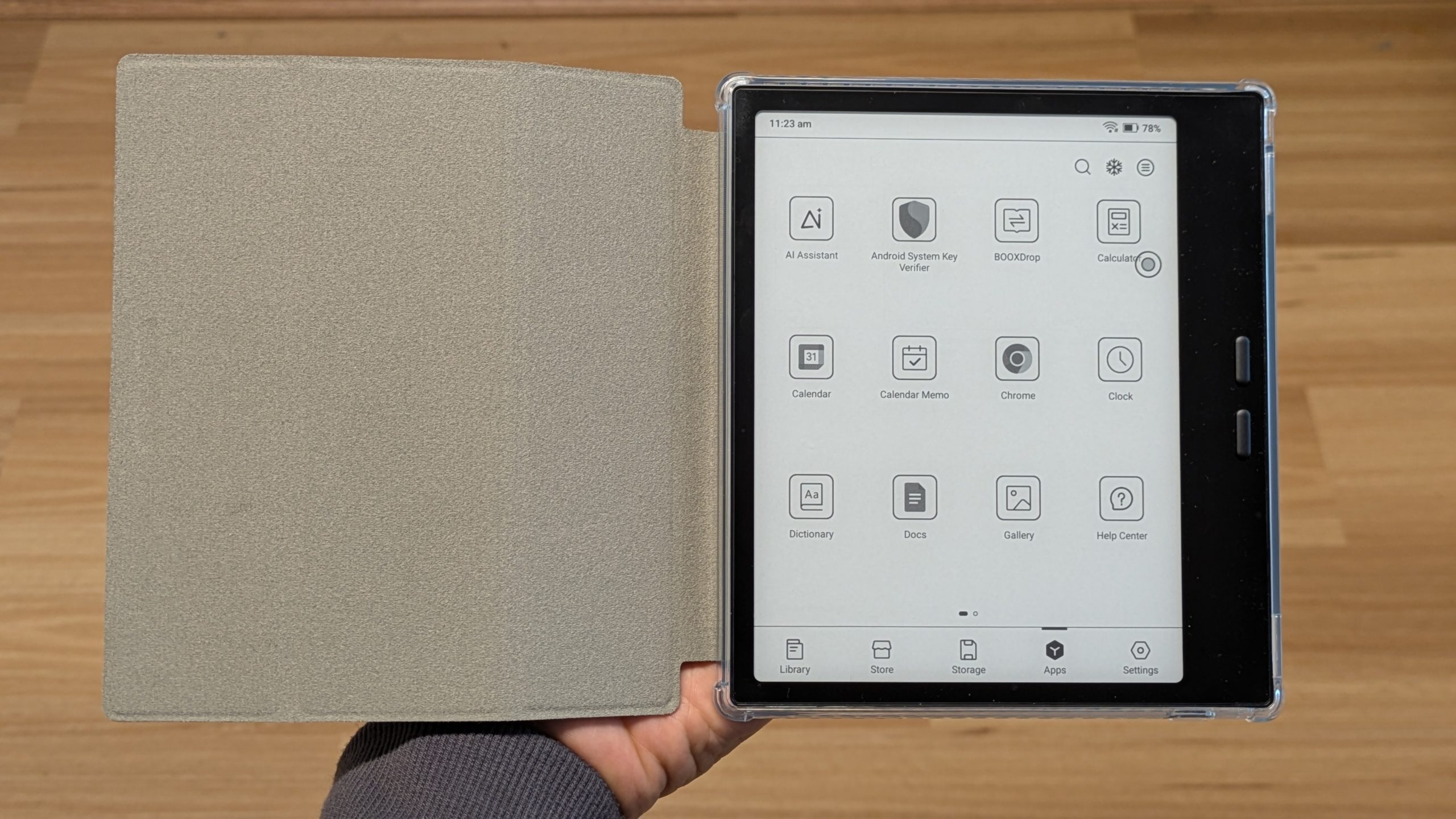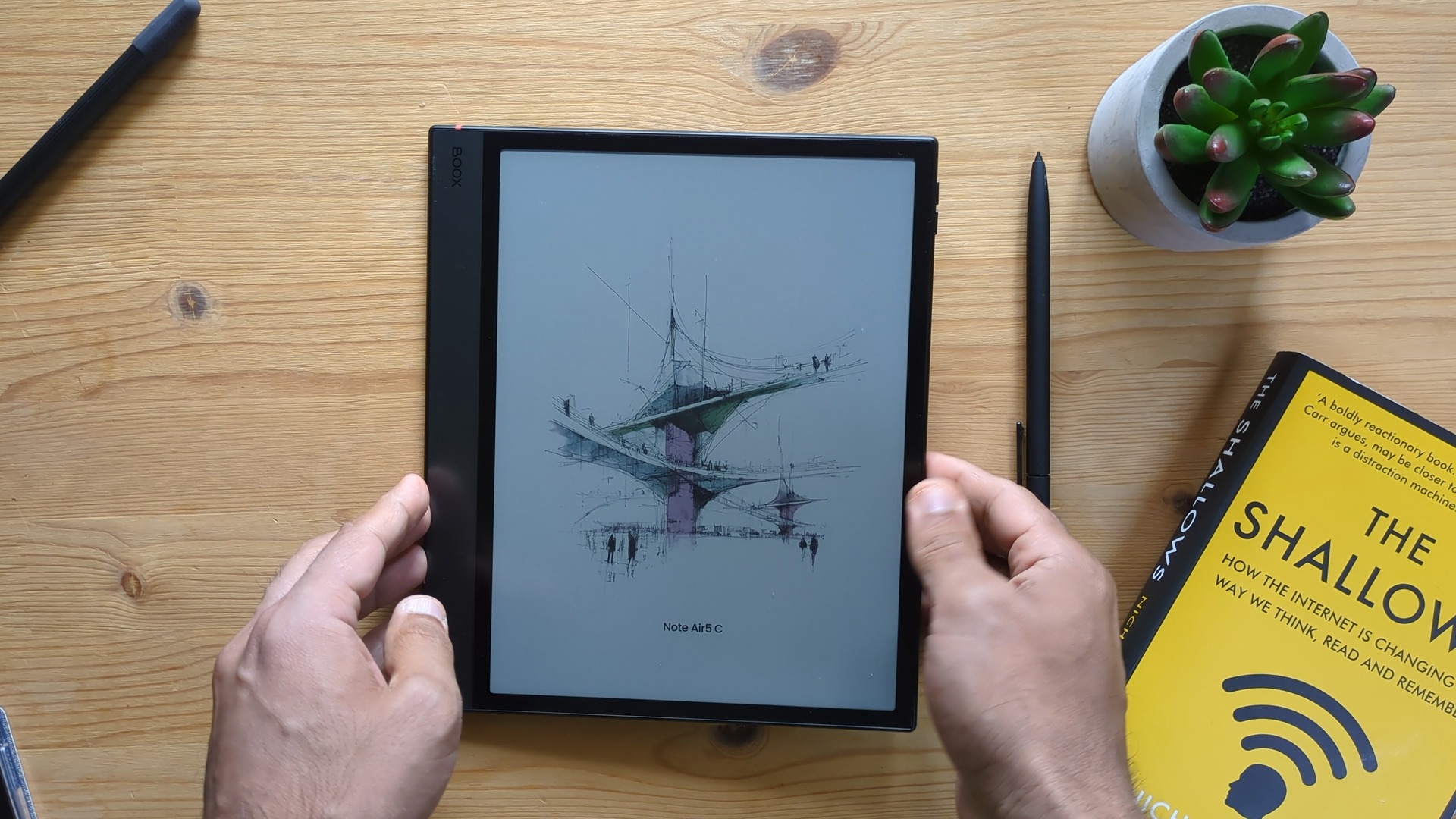The arrival of the Boox Note Air 5C begs a critical question: is this the ultimate E-Ink tablet? As the latest in the Note Air line, this device is an incremental update that carries forward the line’s strengths while introducing key software and accessory enhancements. This review will delve into its design, hardware, screen performance, writing experience, connectivity, and accessories to help you decide if it’s worth the investment.
Design and Build Quality
The Note Air 5C retains the design blueprint of its predecessor, the Note Air 4C, featuring a smooth metallic shell and a glass screen. Aesthetically, it is sleek and professional. Crucially, this smoothness does not equate to fragility; the device feels tough and robust, avoiding a cheap, plasticky feel. The slim aluminum body is spot on: sleek, professional, and built to last.
However, its premium construction comes with a minor trade-off in portability. It weighs about 440g (excluding the folio), which, while comfortable to hold initially, becomes fatiguing for prolonged one-handed use.
The device features a USB-C port on the left-hand side for charging and data transfer. New folios cleverly provide a space for charging the device without needing to keep the cover open, resolving a minor awkwardness from previous models. The power button, located on the top, also conveniently integrates a fingerprint scanner.
One design point that remains awkward is the placement of the pen next to the volume buttons, which can lead to accidental presses when magnetically attaching or putting the pen down. Beside the charging port, a microSD card reader allows for memory expansion up to 2TB.
The device is very well designed, with no creaking or rattling. It feels robust and professional, though the pen placement and the 440g weight are minor drawbacks.
Hardware and Performance
In terms of core specifications, the Note Air 5C is powered by a Snapdragon 750G octa-core processor clocked at 2GHz—the same as the Note Air 4C. It includes 6GB of RAM and 64GB of storage capacity, expandable up to 2TB via the microSD slot.
The inclusion of a Graphics Processor (GPU) is key to running Boox’s Super Refresh Technology (BSR). BSR is essential for configuring third-party apps to work smoothly on the E-Ink display, providing faster refresh rates for tasks like web-browsing or video playback.
While the core specs appear identical to the 4C (as confirmed by the CPU-Z app), the device feels slightly snappier. A failed attempt to run the Geekbench 6 CPU Benchmark (which yielded invalid results) suggests the processor might be slightly overclocked, potentially explaining the perceived speed increase.
Performance is great. Multitasking is fast, and the device is highly responsive, with no major issues encountered.
Kaleido 3
The Note Air 5C sports a 10.3″ Kaleido 3 Color E-Ink display, roughly the size of an A5 page. The underlying E-Ink panel is Carta 1200.
Resolution is sharp for monochrome: 1860 *2480 (300ppi). However, the color filter significantly drops the resolution to 930*1240 (150ppi) when color is active—half the black-and-white resolution.
A common drawback of Kaleido 3 is that it makes the screen appear darker compared to monochrome E-Ink devices. This necessitates the use of the frontlight, which is fortunately quite bright and usually doesn’t need to be set above 80%.
In terms of ghosting, Kaleido screens are generally more susceptible than monochrome displays, but on this device, it is manageable and not frustratingly frequent.
The screen features a Wacom EMR layer, ensuring compatibility with Wacom styli, and a paper-like film for a satisfying writing experience, avoiding a slick, glass-like texture.
The screen is nice, but inherently dark due to the color E-Ink technology. For optimal use indoors or away from a bright window, activating the frontlight is necessary.
Writing Experience
The writing experience is a highlight. The surface offers just the right amount of roughness and friction, creating a satisfying writing-on-paper sound. It is not at all like writing on glass.
The Pen3 Stylus uses a soft nib with a rounded point, providing good precision. A minor, “picky” observation is a very tiny gap between the stylus’s contact point and where the line appears, due to the frontlight layer, though most users will not notice this.
Crucially, there is very little, if any, lag. The line appears instantly, making writing a true joy. In the class of frontlit displays, the Note Air 5C is a winner in this category.
Connectivity and Extras
The tablet includes standard connectivity: Wi-Fi and Bluetooth for peripherals like headphones and keyboards. The USB-C port supports OTG connections for hard drives and USB sticks.
A significant addition over previous models is the presence of POGO pins for connecting an optional magnetic keyboard, which can transform the device into a compact E-Ink word processor.
Other features include a G-Sensor for auto-orientation, a microphone, and dual speakers (which are very basic, but suitable for Text-to-Speech). The fingerprint scanner is integrated into the power button for simple, biometric security.
Battery Life
The Note Air 5C uses the same 3700mAh battery as its predecessor. Due to the GPU and Super Refresh Technology, it is a power-hungry device. Battery life can be extended by limiting the use of the frontlight and turning off Wi-Fi/Bluetooth when not needed.
Based on the 4C’s performance:
- Note-taking: ~6% drain per hour.
- Reading (no lights): ~1% drain per hour.
- Reading (with frontlight): Add ~1% more per hour.
Roughly, with medium use, the device should last about 4 days.
Accessories
The device ships with the latest Pen3 Stylus and a folio cover.
The Pen3 Stylus
The Pen3 has an interesting design—thinner and taller than its predecessor. It works well but can feel a bit top-heavy and slightly unbalanced, which might cause discomfort during long sessions. It includes a nib compartment but lacks an eraser on the top, requiring manual selection of the eraser tool. As it uses Wacom EMR, third-party styli are compatible. It attaches magnetically to the tablet’s right edge, though this attachment can sometimes accidentally press the volume buttons.
The Folio
The folio is appreciated for supporting multiple, unstable-free orientations (landscape and portrait). However, it includes a removable magnetic flap for the pen that can actually interfere with writing when placed under the device. The strong magnet in the flap creates un-writable spots on the screen, an unnecessary design flaw.
Software
The software is where the Note Air 5C sees its most significant change. It ships with Android 15, a major step up from its predecessor. This means longer support and better app compatibility. Boox has also confirmed a planned support for the device for about 7 years, suggesting a superior commitment to software updates.
Conclusion
The Onyx Boox Note Air 5C is a solid, versatile, and feature-packed E-Ink tablet. The writing experience is excellent, the design is premium, and the leap to Android 15 is a crucial improvement for future-proofing and app support. It is highly recommended.
However, if you already own the Note Air 4C, the decision is less clear. The 5C is an incremental hardware update, with the biggest incentive to upgrade being the Android 15 OS and the corresponding long-term software support.
This is arguably the best color E-Ink tablet currently available, a professional-grade notebook and reader with the flexibility of a full Android system.
You can buy it here




